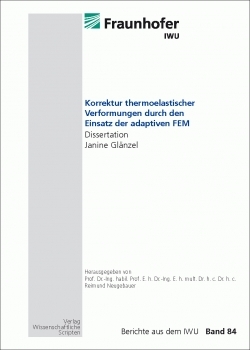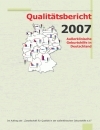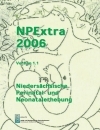|
→ Inhaltsverzeichnis  → Leseprobe → Leseprobe 
R. Neugebauer (Hrsg.)
Dissertation J. Glänzel
Korrektur thermoelastischer Verformungen durch den Einsatz der adaptiven FEM
Berichte aus dem IWU, Band 84
181 Seiten, m. Abb. und Tab., A5, Broschur
ISBN: 9783957350169
Verlag Wissenschaftliche Scripten
In der vorliegenden Arbeit wird aufgezeigt, wie auf Grundlage der Methode der adaptiven Finiten Elemente ein mathematisches Modell zur Berechnung thermoelastischer Verformungen von Werkstücken im Fertigungsprozess entwickelt werden kann. Basierend darauf wird ein Algorithmus zur Korrektur der Positionen aufeinanderfolgender Bohrungen unter Berücksichtigung der thermoelastischen Verformung während des Fertigungsprozesses erstellt. Die berechneten Korrekturwerte können zur Verbesserung der Fertigungsqualität zur Feinpositionierung des Werkzeugs eingesetzt werden.
In einem subadditiven Ansatz des Korrekturalgorithmus wird dieser anschließend zur Bestimmung der Unrundheit der Bohrungskontur erweitert, die nach der Abkühlungsphase des Werkstücks auftreten kann. Optimierungsbetrachtungen zeigen, dass mit einer optimalen Verfahrzeit die auftretenden Bohrungsunrundheiten minimiert werden können. Hierfür werden Optimierungsmöglichkeiten zur Bestimmung der optimalen Verfahrzeiten des Werkzeugs umgesetzt.
Die Kalibrierung der Korrekturmethodik erfolgt durch Experimente zur Bestimmung der wichtigen Stellparameter der Wärmestromdichte und des Wärmeaustauschkoeffizienten, womit das Temperaturfeld durch die adaptive FEM-Simulation bestmöglich reproduzierbar wird. Mit Bezug darauf sind die thermoelastischen Verformungen für die Korrekturwertbestimmung hochgenau abbildbar.
In the presented work it was shown that a mathematical model based on the methods of adaptive finite element could be developed for the calculation of thermo-elastic deformations of workpieces in production processes. This algorithm can also be applied for the position correction of successive drilling while taking into account thermal influences. The calculated correction values improve the quality of the production process as a result of the precisely positioned tool. In a subadditive approach of the correction algorithm, an additional algorithm was developed for the determination of roundness tolerance of the hole contour which can occur after the cooling process of the workpiece. Optimization considerations showed that the roundness tolerance of the hole can be minimized with an optimal travel time of the tool to calculate the optimal travel time, a simulation approach was developed. The calibration of the correction method was established during the experiments, which were carried out to determine the important parameters of heat flux density and the heat Exchange coefficient, whereby the temperature field of the adaptive finite element simulation was best reproducible. In this respect, the thermo-elastic deformations for the Determination of the correction values can be illustrated in a highly accurate form. "
|





